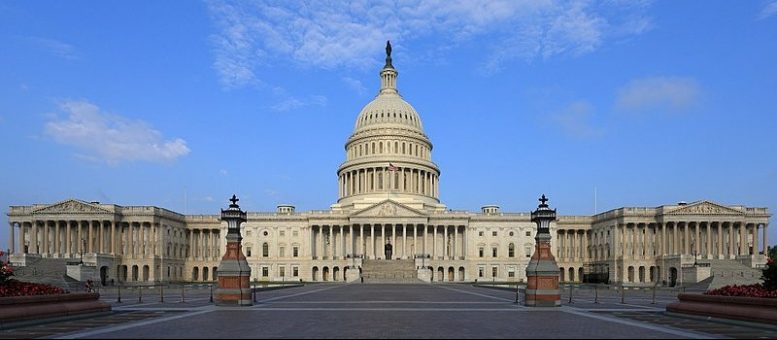Ohio Capital Journal
WASHINGTON — Ohio is projected to lose a U.S. House seat in the coming years, new data show — a change that would diminish the state’s influence in national politics and could lead to less money for federally funded projects and services like roads and health care facilities.
“It’s virtually certain that we will be losing a seat,” said Richard Gunther, professor emeritus of political science at Ohio State University. “We know that there will be some reduction in our representation.”
That’s not because the state is losing people; to the contrary, Ohio’s population has risen by more than 150,000 over the past decade. With an estimated 11.7 million people as of last year, Ohio is the nation’s 7th most populous state.
But other states — particularly those in the Sun Belt — are growing faster.
As a result, Ohio may drop from 16 to 15 members of Congress — continuing a decades-long decline in congressional representation. The state had 24 House seats in the 1960s — its high water mark — but has seen declining representation ever since.
Ohio is on a list of states expected to lose a seat in Congress after the 2020 census, based on data projecting population changes through the end of March, according to Kimball Brace, president of Election Data Services, a political consulting firm.
The state is not unlike its neighbors in the Midwest and Northeast, several of which are also projected to lose out to the South and West.
Under Brace’s projections, Arizona, Colorado, Montana, North Carolina and Oregon are expected to pick up one House seat next year; Florida would gain two; and Texas three. On the losing side are Alabama, California, Illinois, Michigan, Minnesota, New York, Ohio, Pennsylvania, Rhode Island and West Virginia.
But, at this point, projections are merely best guesses. The final count — and the subsequent apportionment of U.S. House members — will depend on the Trump administration’s support for and effectiveness in undertaking the massive project, the public’s response to it and the implications of national events, such as natural disasters, according to Brace.
A full and perfectly precise accounting of the nation’s increasingly diverse and growing population — now estimated at some 330 million — is all but impossible.
Certain groups, such as people of color, homeless people, young children, immigrants and others have been undercounted in the past and may be so again.
The U.S. Supreme Court ruled last year that the 2020 census could not include a question about citizenship status, but some are still wary of providing the government with personal information, according to Tom Wolf, a lawyer with the Brennan Center for Justice.
Another unknown is how the nation’s first “online first” census will play out. Questions remain about whether the project’s internet platform will work and the degree to which people will respond, Wolf said. The census has been underfunded this decade and, as a result, hasn’t been tested as thoroughly as hoped, he said.
He also cited concerns about disinformation about the process on social media. “There are still significant questions about how everything will come together.”
‘Reallocating political power’
The final count will be delivered to the president in December — after the elections this fall — and total population numbers will be available early next year.
The results will have profound implications for Ohioans, in that they will determine who is represented in the nation’s political system and who gets what from the government.
“The census is reallocating political power throughout the country,” Wolf said. “We’re not just talking about the political power of states. We’re also talking about the political power of communities throughout those states.”
Census data are used to apportion seats in Congress, which in turn determines states’ representation in the Electoral College — and their say in presidential elections. They are also used to determine how to distribute billions of dollars in federal funds to states, counties and communities for schools, roads, hospitals and other programs and services.
The loss of another of Ohio’s House seats would likely lead to less influence in Congress and less money for the state, said Chris Warshaw, a professor of political science at The George Washington University. Studies show that the number of seats a state has in Congress affects how much money it gets from the federal government, he added.
That said, Ohio — which would still have a larger delegation than most other states — would still wield considerable influence in Congress and attract attention as a major battleground in presidential elections.
‘Blood on the floor somewhere’
The census results will also be used in redistricting, the process by which new congressional and state legislative district boundaries are drawn. If Ohio loses a seat, Gunther said the state’s mapmakers will have to “depart significantly” from the current map.
“There’s going to be blood on the floor somewhere,” Gunther said. “The question is where.”
For clues, he looks to population shifts in the northeastern part of the state and in and around Columbus and to overall losses in rural areas and gains in urban and suburban ones.
Those shifts could benefit Democratic candidates, according to Paul Beck, a professor emeritus of political science at Ohio State University. But Warshaw doesn’t see such a rosy picture for Democrats if Republicans — who now control the governor’s mansion and both houses of the General Assembly — control the process in 2021.
In 2011, the GOP drew a map that a federal court said was rigged in favor of Republicans, but the U.S. Supreme Court ruled last year that federal courts can’t wade into fights over partisan gerrymandering.
Today, despite the state’s competitiveness in presidential elections, Republicans hold three-quarters of the state’s U.S. House seats and strong majorities in the General Assembly.
Still, partisan gerrymandering might be more difficult under Ohio’s recent redistricting reforms, which establish greater rights for the minority party and support compact districts.
But it won’t necessarily eliminate it, Warshaw said. The process for drawing congressional districts is still mainly controlled by the General Assembly, despite the possibility that a redistricting commission could weigh in if Republicans and Democrats can’t agree on a new map.
The reforms might “take the edge off” of the worst offenses but are generally regarded as weak protections, Warshaw said. Beck agreed, noting that there is still “all kinds of potential for partisan mischief.”





